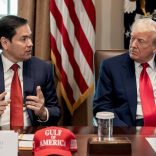Trump foreign aid block stopped again as billions set to expire
Trump extends China truce for 90 days, averting tariff hike

FILE - The Yangshan Deepwater Port in Shanghai.[File photo: Bloomberg]
President Donald Trump extended a pause of sky-high tariffs on Chinese goods for another 90 days into early November, stabilizing trade ties between the world’s two largest economies.
Trump signed an order extending the truce through Nov. 10, deferring a tariff hike set for Tuesday. The de-escalation first took effect when the US and China agreed to reduce tit-for-tat tariff hikes and ease export restrictions on rare earth magnets and certain technologies.
“All other elements of the Agreement will remain the same,” Trump said in a Truth Social post, suggesting no planned changes to US trade policy or to the terms of the arrangement. A fact sheet, posted by the White House, didn’t detail any modifications beyond the date extension.
China, in a similar statement, said it too would extend its own suspension for a further 90 days.
Negotiators from both sides reached a preliminary agreement to keep the deal last month in Sweden. Had the truce not been extended, US tariffs on Chinese goods would have jumped to at least 54% starting after midnight in New York.
The extension will ease worries of a renewed tariff war that threatens to choke off trade between the US and China. An escalation between Washington and Beijing earlier this year shook global financial markets.
It will also give the countries more time to discuss other unresolved issues such as duties tied to fentanyl trafficking that Trump has levied on Beijing, American concerns about Chinese purchases of sanctioned Russian and Iranian oil and disagreements around US business operations in China.
The signing may clear the path for Trump to visit China to meet with President Xi Jinping in late October, around the time of an international meeting in South Korea that the US leader is likely to attend.
“The United States continues to have discussions with the PRC to address the lack of trade reciprocity in our economic relationship and our resulting national and economic security concerns,” Trump wrote in the order. “Through these discussions, the PRC continues to take significant steps toward remedying non-reciprocal trade arrangements and addressing the concerns of the United States relating to economic and national security matters.”
Trump, speaking to reporters earlier Monday, said “we’ve been dealing very nicely with China.”
Trump earlier this year ratcheted up tariffs on Chinese goods, and Beijing responded in kind. US tariffs on Chinese imports ultimately reached 145%, and China curbed access to magnets critical to US manufacturers. The two sides reached a 90-day truce in May, under which the US lowered its China duties to 30% while Beijing reduced levies on US goods to 10% and agreed to resume rare earth exports.
Trump’s willingness to parlay with China has prompted concerns from national security hawks that he’s unwilling to crack down on the US’s biggest geopolitical rival. Nvidia Corp. and Advanced Micro Devices Inc. reached deals with the Trump administration to secure export licenses by agreeing to pay 15% of their revenues from certain Chinese artificial intelligence chip sales to the US government.
Trump earlier Monday also signalled openness to separately allowing Nvidia to sell a scaled-back version of its most advanced AI chip to China, saying that “it’s possible I’d make a deal.”
What Bloomberg Economics says …
This reprieve does little to change China’s increasingly precarious trade position. The July – early August wave of bilateral deals between the US and other countries has left China in a weaker spot. As other countries struck deals to secure lower tariffs with the US, China finds itself among the few major economies without a clear timeline or terms for a deal.
Trump’s decision to extend the truce follows two days of discussions in Stockholm in July led by US Treasury Secretary Scott Bessent and Chinese Vice Premier He Lifeng — the third round of talks between Washington and Beijing in less than three months.
While Chinese officials and the Communist Party’s official newspaper had signaled satisfaction with the Stockholm talks, and US Cabinet secretaries predicted an extension, the pact remained fragile. Bessent had said that any decision to extend the deal would be up to Trump.
Rare earths
At issue in the ongoing dialogue is how the two countries will seek to maintain a stable trading relationship while applying barriers like tariffs and export controls to limit each other’s progress in critical sectors including battery technology, defence and semiconductors.
US Trade Representative Jamieson Greer, who participated in the Stockholm negotiations, has sounded an optimistic note on discussions with China over rare earth flows, saying that the US had secured commitments about their supply.
“We’re focused on making sure that magnets from China to the United States and the adjacent supply chain can flow as freely as it did before the control,” Greer told CBS’s Face the Nation in a recent interview. “And I would say we’re about halfway there.”
Flows of rare earth magnets from China to the US rose to 353 tons in June, up from just 46 tons in May, according to the latest customs data. Total shipments were still substantially lower than before Beijing launched export controls in early April.
Tariff push
China-US negotiations have been on a separate track from other talks the Trump administration has held with trading partners as it moves to implement sweeping so-called reciprocal tariffs and industry-specific levies on other economies.
Trump’s 30% duties are comprised of a 20% levy tied to fentanyl and a 10% baseline charge. That’s on top of existing tariffs on certain Chinese products from his first term.













Leave a Reply
Be the First to Comment!
You must be logged in to post a comment.
You must be logged in to post a comment.